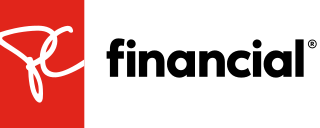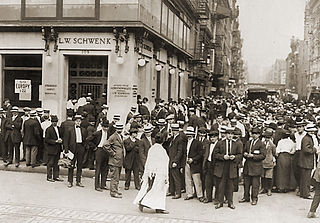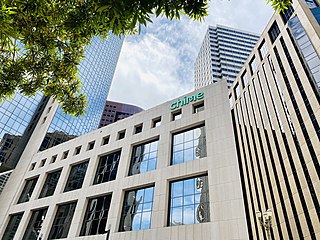
The Federal Deposit Insurance Corporation (FDIC) is a United States government corporation supplying deposit insurance to depositors in American commercial banks and savings banks. The FDIC was created by the Banking Act of 1933, enacted during the Great Depression to restore trust in the American banking system. More than one-third of banks failed in the years before the FDIC's creation, and bank runs were common. The insurance limit was initially US$2,500 per ownership category, and this has been increased several times over the years. Since the enactment of the Dodd–Frank Wall Street Reform and Consumer Protection Act in 2010, the FDIC insures deposits in member banks up to $250,000 per ownership category. FDIC insurance is backed by the full faith and credit of the government of the United States, and according to the FDIC, "since its start in 1933 no depositor has ever lost a penny of FDIC-insured funds".

In the United States, banking had begun by the 1780s, along with the country's founding. It has developed into a highly influential and complex system of banking and financial services. Anchored by New York City and Wall Street, it is centered on various financial services, such as private banking, asset management, and deposit security.

A transaction account, also called a checking account, chequing account, current account, demand deposit account, or share account at credit unions, is a deposit account or bank account held at a bank or other financial institution. It is available to the account owner "on demand" and is available for frequent and immediate access by the account owner or to others as the account owner may direct. Access may be in a variety of ways, such as cash withdrawals, use of debit cards, cheques and electronic transfer. In economic terms, the funds held in a transaction account are regarded as liquid funds. In accounting terms, they are considered as cash.

Online banking, also known as internet banking, virtual banking, web banking or home banking, is a system that enables customers of a bank or other financial institution to conduct a range of financial transactions through the financial institution's website or mobile app. Since the early 2000s this has become the most common way that customers access their bank accounts.
Manulife Bank of Canada is a wholly-owned subsidiary of Manulife. As a direct bank, it offers high-interest chequing & savings accounts, credit cards, lines of credit and mortgages, including Manulife One. Since it was established in 1993, Manulife Bank has grown to more than $29 billion in assets and serves customers across Canada. Manulife Bank headquarters are in Waterloo, Ontario.

President's Choice Financial, commonly shortened to PC Financial, is the financial service brand of the Canadian supermarket chain Loblaw Companies.

Oversea-Chinese Banking Corporation Limited, abbreviated as OCBC, is a Singaporean multinational banking and financial services corporation headquartered at the OCBC Centre.
NetBank, formerly named Atlanta Internet Bank (1996) and Net.B@nk (1998), was an American direct bank that operated between 1996 and 2007. Netbank suffered from bank failure and was closed by regulators on September 28, 2007.

A bank failure occurs when a bank is unable to meet its obligations to its depositors or other creditors because it has become insolvent or too illiquid to meet its liabilities. A bank typically fails economically when the market value of its assets falls below the market value of its liabilities. The insolvent bank either borrows from other solvent banks or sells its assets at a lower price than its market value to generate liquid money to pay its depositors on demand. The inability of the solvent banks to lend liquid money to the insolvent bank creates a bank panic among the depositors as more depositors try to take out cash deposits from the bank. As such, the bank is unable to fulfill the demands of all of its depositors on time. A bank may be taken over by the regulating government agency if its shareholders' equity are below the regulatory minimum.
Bank regulation in the United States is highly fragmented compared with other G10 countries, where most countries have only one bank regulator. In the U.S., banking is regulated at both the federal and state level. Depending on the type of charter a banking organization has and on its organizational structure, it may be subject to numerous federal and state banking regulations. Apart from the bank regulatory agencies the U.S. maintains separate securities, commodities, and insurance regulatory agencies at the federal and state level, unlike Japan and the United Kingdom. Bank examiners are generally employed to supervise banks and to ensure compliance with regulations.

A bank is a financial institution that accepts deposits from the public and creates a demand deposit while simultaneously making loans. Lending activities can be directly performed by the bank or indirectly through capital markets.
Nevada State Bank, a division of Zions Bancorporation, N.A. Member FDIC, is a full-service bank with branches statewide. Founded in 1959, Nevada State Bank serves 20 communities across the state of Nevada. Zions Bancorporation, N.A. operates in nearly 500 local financial centers across 11 Western states: Arizona, California, Colorado, Idaho, Nevada, New Mexico, Oregon, Texas, Utah, Washington and Wyoming. Zions Bancorporation, N.A. is included in the S&P 400 Mid-Cap and NASDAQ Financial 100 indices.

Wright-Patt Credit Union (WPCU) is a US credit union or financial cooperative headquartered in Beavercreek, Ohio. The credit union was originally headquartered in Fairborn, Ohio; however, it relocated in early 2014. WPCU is registered as a state-chartered credit union, is the largest member-owned credit union in Ohio, and is one of the 50 largest credit unions in the United States. As of February 2022, WPCU has over $7.1 billion in assets, and over 446,000 members. WPCU is federally insured by the National Credit Union Administration (NCUA), which insures accounts in federal and most state-chartered credit unions in the United States. Deposits with Wright-Patt Credit Union are insured to $250,000.

The Insured Cash Sweep or ICS service is used by banks and savings associations that are insured by the Federal Deposit Insurance Corporation (FDIC). In 2021, the service was reconfigured with several others offered by IntraFi Network into IntraFi Network Deposits and IntraFi Funding.
Simple was an American neobank based in Portland, Oregon. It was recognized as the first neobank and operated between 2009 and 2021.
IntraFi, LLC, is a privately held firm with a network of more than 3,000 financial institutions, three-quarters of all U.S. commercial banks and thrifts as members. Among its members are 23 of 25 top U.S. banks and 95% of all U.S. community banks. The company’s headquarters is in Arlington, Virginia.

A neobank is a type of direct bank that operates exclusively using online banking without traditional physical branch networks that challenge traditional banks.
Good Money is an American digital online banking platform, often called a neobank, founded by Gunnar Lovelace. Good Money directs 50% of its profits toward environmental and social justice initiatives through impact investments and charitable donations. As a digital platform, Good Money takes no ATM or overdraft fees. The platform's customers vote on where Good Money will invest profits, but their options only include sustainable investments. It is based in San Francisco.

Chime Financial, Inc. is a San Francisco–based financial technology company that partners with regional banks to provide certain fee-free mobile banking services. The company offers early access to paychecks, negative account balances without overdraft fees, high-yield savings accounts, peer-to-peer payments, and an interest-free secured credit card. Chime's mobile banking services do not rely on monthly service or overdraft fees or minimum balance requirements. Chime earns the majority of its revenue from the collection of interchange fees on debit card transactions.
Current is an American financial services and software development company (FinTech) based in New York City. It provides mobile banking services through its partner bank, Choice Financial Group.










